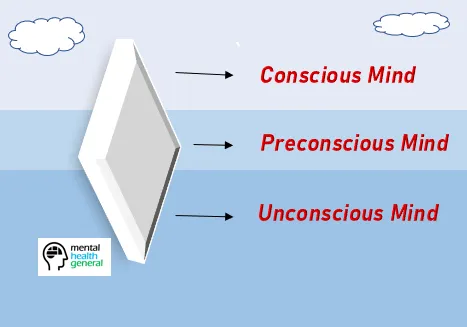Some theories in mental health suggest that our mind consists of multiple layers, with certain thoughts, feelings and memories being blocked from our conscious mind. These thoughts are said to reside in our unconscious mind.
Sigmund Freud pioneered this theory, and argued that unprocessed elements in our unconscious mind affects us to this day, and causes mental disturbances that result in mental illnesses like Depression or Anxiety.
If this theory is accurate, then a key question is how can an individual reach their unconscious mind? This forms a key part of Freud’s theory of Psychoanalysis.
Freud’s Theory of the Mind
Sigmund Freud’s theory of the mind is well-known. Freud argued that there are three parts to the mind – the unconscious mind, the preconscious mind and the conscious mind.
We have an article that provides an overview and explores the differences of these three levels of the mind, which you can view by clicking here.
As mentioned, Freud suggested that certain thoughts, feelings and memories are located in the unconscious mind. These normally relate to traumatic experiences, and therefore as a defence mechanism, the mind didn’t process them, causing them to be stuck in the unconscious mind.
But this continues to cause problems for the person, as these areas in the unconscious mind haven’t been processed properly. Therefore, Freud argues that in order to improve our mental health, we need to bring these areas to the conscious mind, in order for us to process them healthily.

Techniques to bring the unconscious to our conscious
Freud suggested that using his theory of Psychoanalysis, that it would be possible to bring certain areas from the unconscious to the conscious. He proposed using three main techniques to achieve this:
- Dream Analysis: A common technique employed is dream analysis – which is the idea that the dreams or nightmares that a person has is very important. Freud suggested that the dreams humans have are often crafted by the life around us. Freud suggested that dreams are a disguised fulfilment of a wish, and that by analysing dreams, potential areas that are troubling an individual can be identified. Essentially, a person’s dream may show a wish they have (often an unconscious wish) fulfilled – though there is a reason outside of their awareness for this.
- Freudian Slips: Also known as a slip of the tongue, this is where a person – when talking or writing, acts in a slightly unusual way. They may say or write something that is not in keeping with a topic, or that they didn’t consciously mean to say. Freud suggested that these slips, or ‘para praxes’ as he called them, come from the unconscious mind, and actually reflect the true thoughts of someone. Freud argues that a therapist should therefore pay attention to everything that their patient says – there is no such thing as a “throwaway comment”, he says.
- Free word association: Word association refers to an instance where a person is allowed to freely speak their mind. In therapy, a person would relax, and talk about anything that comes to mind – regardless of its nature. The therapist would look out for common themes or patterns. Freud suggested that word association could help in uncovering content from the unconscious mind. As many of the areas in the unconscious mind are negative, a patient may secretly yearn to get over a certain trauma. Free word association may enable this process to happen.
This combination of techniques, along with regular discussions and conversations, can help a therapist to allow unconscious thoughts, feelings and memories come to the conscious mind, according to Freud.
In the modern age, Psychoanalytical Psychotherapy and Psychodynamic Psychotherapy are the main two types of therapy that base their foundation on Freud’s theory of Psychoanalysis.
Summary
Freud’s theory of the mind is an important part of his overall ideas, and has certainly impacted the field of psychology.
As ever, regardless of the techniques used, what is most important is that a person manages to get effective help when they are struggling with their mental health.
See Also
- Overview of Sigmund Freud’s Theories
- Freud’s Theory of the Unconscious, Conscious and Preconscious Minds in Mental Health
- What is the Unconscious Mind in Mental Health?
- What is the Preconscious Mind in Mental Health?
- What is the Conscious Mind in Mental Health?
- What is the Difference Between The Unconscious and Conscious Mind in Mental Health?
- How Can You Reach the Unconscious Mind in Mental Health Therapy?
- Homepage
Disclaimer
This website should be used purely for informational purposes, and does not intend to, nor should it ever, be used as a replacement for professional medical advice.
We strive to keep all of our pages updated, and ensure that our website is full of factual and in-depth information. However, we encourage you to browse this website with care.
As a reminder, this website and all content within it cannot and should not replace the advice of a trained medical professional. You can read our full disclaimer at this link.
Helplines
If you are struggling with your mental health, help is available. With the right support and treatment, you can make a recovery. For information on helplines, or if you are in a state of crisis, please visit our crisis page by clicking on the relevant link for your geographical location (United Kingdom), (United States), (International). You can also see how to get mental health treatment and the process involved by clicking this link.


































